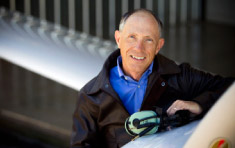Training, technology round out safety
 There’s an old country saying about why it’s a bad idea to teach a pig to sing: You won’t like the result and it annoys the pig.
There’s an old country saying about why it’s a bad idea to teach a pig to sing: You won’t like the result and it annoys the pig.
I’ve lost arguments with friends and with myself on the appropriate level of refresher training for private pilots. As with all things complex, there are many shades of gray.
I have a standing bet that if pilots simply performed to the FAA’s practical test standards as they’ve existed for decades, the personal aviation accident rate would plummet. Likewise, if we could just get drivers to approximate the basic skill level when they took their driver’s test, the rate of car accidents would fall. Neither concept is realistic given the nature of our fellow humans. It’s called the bell-shaped curve.
Almost everyone thinks he or she is better than the average driver. The reality is less flattering. If we’re going to allow more than a select few to engage in personal aviation (or driving), we’ll also have to allow some variability in skill and judgment. Sadly, in the words of comedian Ron White, “You can’t fix stupid.” There will always be some really dumb accidents, but, in exchange, many more people can participate. Where to set the bar?
The flight review, established about four decades ago, attempted to provide some level of guidance, and it was a politically feasible solution. It isn’t perfect by any stretch, and the CFIs who administer it are also governed by that inevitable curve. Some hard-nosed types will practically recertify a pilot, while the slackers merely fly to lunch and back. Most will be somewhere in the middle. Ultimately, it comes down to how good you want to be.
How would you feel about requiring some more time spent on stalls, slow flight, and takeoffs and landings? They’ve been a part of every review I’ve ever completed, because that’s where the accidents are. But given the evidence of lousy airmanship in many accidents, changing human behavior is devilishly tough. It’s much easier to redesign the machine interface.
After flying and teaching in this environment for a long time, I’m encouraged that technology solves many problems where human behavior modification and massive regulation fail. The greatest improvement in airline flying happened with the introduction of the jet engine, and not because pilots suddenly got more capable. Jets were vastly more reliable than the old radials. Likewise, enhanced ground proximity warning and collision avoidance systems have almost eliminated controlled flight into terrain and midairs for the big airplanes—something that training alone never accomplished.
The airline/military/bizjet world has excellent equipment, rigorous pilot selection, immense (expensive) oversight, and training to evolve into a near-perfect system. That’s not feasible for many in light personal aviation, because then it becomes something else.
Avionics are far superior to decades ago: weather in the cockpit, GPS, moving maps, enhanced engine monitoring, terrain databases, better radios, autopilots, et cetera. The light GA safety record will never approach air carrier performance, but it has improved significantly—and not because pilots have gotten appreciably better. However, you can choose to become more capable by expanding your training—and with the better hardware, flying becomes much safer.
What about that big killer: loss of control? I’m reluctantly conceding that technology may well provide a better long-term outcome in aggregate than trying to get the entire bell-shaped curve of pilots and instructors to achieve a significantly better outcome. (Note the qualifiers and understand there will be different opinions—all cheerfully accepted!)
Partial-panel training, for example, has been with us forever, with mixed results. On my ATP checkride, the inspector failed most of the aircraft until the clock, the turn coordinator, and the fool in the left seat were about the only things working. Subsequently, I survived a real vacuum-pump failure in low IMC and landed out of a partial-panel ILS. So, training works, but it takes a lot of effort and must be reinforced regularly because humans are consistently inconsistent. The slackers—CFIs or pilots—won’t work that hard and a few pay the price.
Good training is worth every penny, but don’t oversell the results. Training success depends upon the integrity of CFIs, pilots, and the reality of human learning/retention. Go for a quickie flight review, if you insist, but don’t ask me to endorse your logbook.
Flight envelope protection is probably the next big step forward, even as we provide special stall and slow-flight emphasis programs. Angle of attack instrumentation is a steppingstone. The new technology certainly isn’t for every aircraft or pocketbook, and that means you just need some of that pilot stuff. Is that asking the pig to sing?
Bruce Landsberg is the former president of the AOPA Foundation and is a senior safety advisor to the AOPA Air Safety Institute.



